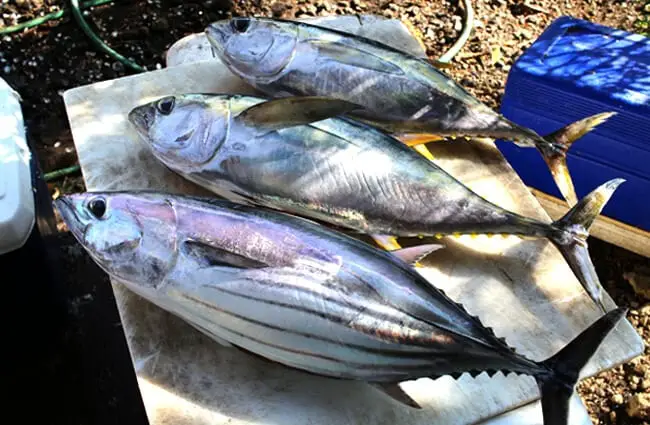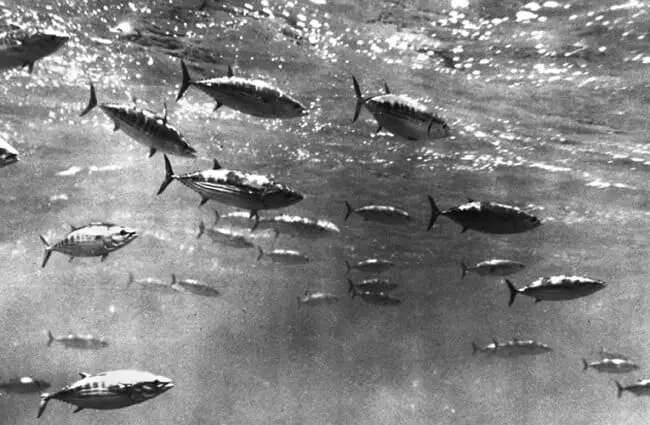A Deep Dive into the World of Skipjack Tuna
Skipjack tuna (Katsuwonus pelamis) is a globally significant fish, playing vital roles in marine ecosystems and human economies. Often overlooked in favor of its larger cousins, the skipjack is a fascinating creature with a unique biology, complex behaviors, and a surprising impact on our world. This article provides a comprehensive exploration of the skipjack tuna, from its natural history and ecological importance to its interactions with humans.

Basic Biology and Identifying Characteristics
The skipjack tuna is a relatively small tuna species, typically reaching lengths of around 30 to 50 centimeters and weights between 1.5 to 3 kilograms, although larger individuals can occur. Its streamlined body is built for speed, and its dark metallic blue back contrasts with a silvery white belly. Two distinct yellow stripes run along its sides, a key identifying feature. Notably, skipjack possesses small second dorsal and anal finlets, and a deeply forked tail and adaptations for powerful swimming. Unlike some other tuna species, skipjack lacks scales except along the lateral line. Skipjack tuna are considered warm‑water fish, preferring temperatures between 18°C and 28°C.
Habitat and Distribution
Skipjack tuna boasts a remarkably wide distribution. Found in tropical and subtropical waters across the globe, this pelagic species inhabits the Atlantic, Pacific, and Indian Oceans. They are often found near surface waters, associated with ocean currents and upwelling zones, where nutrient‑rich waters support a flourishing food web. Skipjack tuna frequently gather around floating objects, such as seaweed rafts or man‑made debris, using them as foraging grounds and shelter. They are highly migratory, traveling long distances throughout their lives in search of food and suitable breeding grounds. In the Atlantic, they are common in the Gulf of Mexico and along the coasts of Africa and South America. In the Pacific, they are abundant near Hawaii, Japan, and the coasts of Central and South America.

Diet and Foraging Behavior
Skipjack tuna are opportunistic predators with a varied diet. Small fish, squid, and crustaceans form the bulk of their meals. They actively hunt in schools, using their speed and agility to chase down prey. Skipjack often forage near the surface, but they can also dive to considerable depths in pursuit of food. The association with floating objects isn’t just coincidental; these structures attract smaller fish and invertebrates, creating concentrated feeding opportunities. Their digestive system is highly efficient, allowing them to extract maximum nutrients from their prey. They are also known to consume jellyfish and other gelatinous organisms.
Reproduction and Life Cycle
Skipjack tuna exhibit a rapid growth rate and a relatively short lifespan, typically living between 3 and 5 years. They reach sexual maturity surprisingly early, often within their first year of life. Spawning occurs throughout the year in warmer waters, with peak periods varying by location. Skipjack are broadcast spawners, meaning females release eggs into the water column, where they are fertilized externally by males. The eggs are pelagic, drifting freely with the currents. The larvae hatch within a day or two and undergo a period of rapid development. Young skipjack feed on plankton before transitioning to small fish and squid. Skipjack tuna are prolific breeders, with females capable of producing millions of eggs during their lifetime. The high reproductive rate contributes to their abundance and resilience.

Ecological Role and Interactions
Skipjack tuna play a crucial role in marine ecosystems as both predators and prey. They exert top‑down control on populations of smaller fish and invertebrates, helping to regulate the food web. They themselves are preyed upon by larger tuna species, sharks, billfish, and marine mammals. Skipjack tuna serve as an important link in transferring energy from lower trophic levels to higher ones. Their migratory patterns contribute to the dispersal of nutrients and the connectivity of different marine habitats. They compete with other tuna species for resources, and their abundance can influence the dynamics of the entire ecosystem. The health of skipjack tuna populations is often used as an indicator of overall ocean health.
Skipjack and Humans: A Complex Relationship
Skipjack tuna is one of the most commercially important tuna species globally. It constitutes a significant portion of the tuna consumed worldwide, finding its way into canned tuna, sushi, sashimi, and other culinary delights. Its fast growth rate and high reproductive capacity have allowed it to withstand fishing pressure better than some other tuna species. However, overfishing remains a concern, and sustainable fishing practices are crucial to ensure the long‑term health of skipjack populations. The use of fish aggregating devices (FADs) in tuna fisheries has raised environmental concerns, as these devices can attract other marine species and contribute to bycatch.

Advanced Insights for Zoologists and Researchers
Current research focuses on several key areas. Population genetics studies are elucidating the structure and connectivity of skipjack tuna populations across different ocean basins. Tagging studies are tracking the migratory patterns and habitat use of individual fish, providing valuable insights into their life history. Researchers are also investigating the effects of climate change and ocean acidification on skipjack tuna populations and their prey. Understanding the physiological adaptations that allow skipjack to thrive in a wide range of environmental conditions is another area of ongoing research. Studying the impact of FADs on skipjack tuna and other marine species is crucial for developing more sustainable fishing practices.
Encountering Skipjack in the Wild and Responsible Interaction
If you’re fortunate enough to encounter skipjack tuna while snorkeling or diving, observe them from a respectful distance. Avoid any actions that could disturb or stress the fish. Do not attempt to feed or touch them. If you’re fishing, adhere to all local fishing regulations and practice catch and release whenever possible. Report any unusual sightings or behaviors to local marine authorities.
Caring for Skipjack in Captivity
Maintaining skipjack tuna in captivity is extremely challenging due to their pelagic lifestyle and high swimming speeds. Large, deep tanks with strong water currents are essential. A varied diet of fresh fish, squid, and crustaceans must be provided. Maintaining optimal water quality is critical. Regular veterinary checkups are necessary to monitor the fish’s health. Providing environmental enrichment, such as artificial reefs or currents, can help reduce stress. Avoid overcrowding, as this can lead to aggression and disease.
Skipjack tuna, though often overlooked, are a remarkable creature worthy of our attention and conservation efforts. By understanding its biology, ecology, and interactions with humans, we can ensure its continued survival for generations to come.

![Red Angus Closeup of a beautiful Red Angus cowPhoto by: U.S. Department of Agriculture [pubic domain]https://creativecommons.org/licenses/by/2.0/](https://animals.net/wp-content/uploads/2020/03/Red-Angus-4-238x178.jpg)




![Red Angus Closeup of a beautiful Red Angus cowPhoto by: U.S. Department of Agriculture [pubic domain]https://creativecommons.org/licenses/by/2.0/](https://animals.net/wp-content/uploads/2020/03/Red-Angus-4-100x75.jpg)

